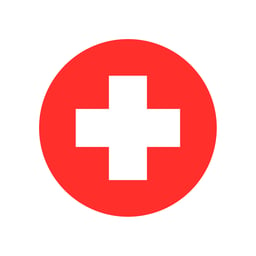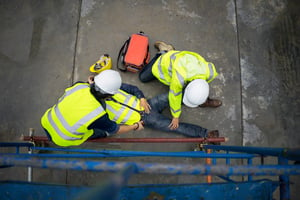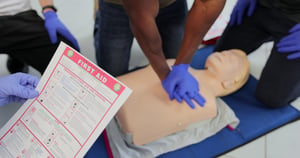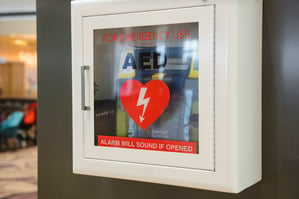
At any time, an emergency can happen to any of us – at home, at work or anywhere else. In certain emergencies, such as a cardiac event or severe allergic reaction, every minute matters when it comes to providing appropriate care.
The idea of an emergency happening to someone you know or love might cause anxiety, but it doesn’t have to cause panic. Fortunately, there are some basic safety trainings that can help prepare you to help in case some of the most common emergencies occur. Many workplaces may offer these trainings to employees, or you can seek them out yourself.
Most courses are offered online as well as in-person, making them convenient to take, though online classes may not qualify you for certification since you cannot demonstrate the skill to the instructor.
Below, find some of the trainings worth signing up for, as well as some basic steps to know if you find yourself faced with an emergency.
First Aid

First aid is a broad term for basic medical treatment given to someone requiring immediate assistance – and it covers a lot. According to the American Red Cross, their first aid certification includes how to respond to:
|
|
|
|
|
|
|
|
|
|
|
|
Additionally, first aid may vary based on whether the affected individual is an adult or a child. To know how to help children and babies, additional training is often required.
Getting first aid training can give you confidence to help in an emergency and could even save the life of the person you’re helping. However, even without training, there are a few basic steps everyone should know when it comes to first aid.
According to the American Red Cross, the below steps should be taken in the event of an emergency:
-
Check the scene for safety for yourself and obtain consent to treat if the affected person is conscious.
-
If the person appears unresponsive, check for a pulse, breathing issues, heavy bleeding or other conditions that appear life threatening.
-
If the person remains unresponsive, call 911 immediately and begin providing care if you’re trained. If they’re not breathing, perform
CPR and use an AED as soon as possible. If there is a bystander, then direct them to call 911. This allows the trained individual to focus on the victim. - If the person is responsive, ask the person and any bystanders about what happened, including any allergies, medications, or other medical conditions. However, don’t ask the person to move if you suspect a head, neck, or spinal injury, and don’t ask them to move anything that hurts.
First aid training can teach you how to respond in different emergency scenarios, and certification ensures that a professional has signed off on your abilities.
To find a class near you, visit the American Red Cross website.
Cardiopulmonary Resuscitation (CPR)

One of the most common safety trainings is cardiopulmonary resuscitation, or CPR, training. CPR is performed when someone stops breathing or has a cardiac event, and it can provide life-saving care until emergency responders arrive.
The best thing to do when it comes to CPR education is to get certified. However, if you’re not certified, the American Red Cross provides step-by-step instructions on what to do if someone has a cardiac emergency:
-
Call 911 or tell someone to call 911.
-
Place the person on their back on a firm, flat surface.
-
Give 30 chest compressions.
-
Hand position: two hands centered on the chest
-
Body position: shoulders directly over hands; elbows locked
-
Depth: at least 2 inches
-
Rate: 100 to 120 per minute
-
Allow chest to return to normal position after each compression.
-
-
Give two breaths.
-
Open the airway to a past-neutral position using the head-tilt/chin-life technique.
-
Ensure each breath lasts about 1 second and makes the chest rise; allow air to exit before giving the next breath.
-
If the first breath does not cause the chest to rise, re-tilt the head and ensure a proper seal before giving the second breath. If the second breath does not make the chest rise, an object may be blocking the airway.
-
-
Continue in this pattern and use an AED as soon as possible.
It’s important to note that the above is the CPR method to be used on adults. Babies and children require special training and treatment. You can learn more about performing CPR on them here: https://www.redcross.org/take-a-class/cpr/performing-cpr/child-baby-cpr.
Automated External Defibrillator (AED)

An automated external defibrillator, or AED, is a device used on someone if their heart stops. It uses a shock to re-establish a heart rhythm,
potentially saving that person’s life. On average, it can take emergency responders 8-12 minutes to arrive at an emergency – and in a situation with cardiac arrest, every minute matters. In fact, for each minute using an AED is delayed, odds of survival are reduced by about 10%.
Using an AED is simple, and training is usually included in any first aid or CPR trainings. The American Red Cross outlines the steps below:
-
Check that the person is not breathing and not responding, and call 911 or tell someone to call 911.
-
As soon as an AED is available, turn it on and follow the voice prompts.
-
Remove clothing and attach pads correctly.
-
Remove all clothing covering the chest. If necessary, wipe the chest dry.
-
Place one pad on the upper right side of the chest.
-
Place the other pad on the lower left side of the chest, a few inches below the left armpit.
-
-
Plug the pad connector into the AED if necessary
-
Let the AED analyze the heart’s rhythm. Make sure no one is touching the person and say, “CLEAR!” in a loud, commanding voice
-
Deliver a shock if the AED determines it is needed.
-
Make sure no one is touching the person
-
Say, “CLEAR!” in a loud, commanding voice
-
Push the “shock” button to deliver the shock
-
-
After the shock, if no other shock is advised, start CPR, beginning with compressions.
Ideally, you’ll become AED certified so that you know exactly what to do if you’re in a situation where an AED is needed. Training lasts two years and is often combined with other safety certifications. Register for a training.
Make Every Minute Count in an Emergency
No one wants to believe that an emergency can happen to them, but the truth is it can happen to any of us. One of the best things you can do to stave off the worst-case scenarios is to spend the time to become certified in first aid, CPR and AED use. While the trainings themselves may only take a few hours, doing them could result in someone else having extra years of their life.
At CertaSite, safety is our absolute priority in everything we do. We can make sure that your business has all of the first aid and life safety equipment you could need, as well as maintaining proper inspection cycles, spotting and correcting deficiencies, providing installation and more.




